MEMBERS’ REWARDS
Enjoy over £200 of savings with our latest offers!


MEMBERS’ REWARDS
Enjoy over £200 of savings with our latest offers!

Explore majestic castles, historic houses and glorious gardens with your membership this spring



















MONUMENT PORTRAITS






150 years of person l otos at S +
MONUMENTAL
p ge s new exhibition
WIND OF CHANGE

The conservation project to rescue Saxtead Green Post Mill in Suffolk






NOTES FROM HISTORY
The notebooks and letters helping to reveal the stories of our sites












Discover this magnificent collection of 19 country house hotels and island resorts across the UK and Channel Islands.
Save 25% with our Two Night Wine & Dine Break! Enjoy two nights in a stylish bedroom with a bottle of 2000 Bordeaux wine in your room on arrival, a £35 allocation towards dinner per person each night, and a full traditional breakfast both mornings.
Which of our hotels will tempt you? Simply visit our website and enter the promo code to redeem this offer*.
handpickedhotels.co.uk
Get in touch
W www.english-heritage.org.uk/members
E membersmagazine@immediate.co.uk (for magazine queries only) or members@english-heritage.org.uk (for membership queries)
T 0370 333 1181 PO Box 569, Swindon, SN2 2YP
For English Heritage Luke Whitcomb, Johanna Lovesey, Jeremy Ashbee, Tom Dennis, Tersia Boorer, Tony Dike, Katie Kennedy, Richard Leatherdale
For Immediate Media Co.
Group editor Matt Havercroft
Group production editor Oliver Hurley
Senior art editor Sam Freeman
Art editor Elaine Knight-Roberts
Account director Esther Procee
Account manager Joanne Robinson
Director Julie Williams
Editorial director Dan Linstead
Design director Will Slater
Consultant editor Dave Musgrove
Advertising manager Jamie Bolton
Advertising enquiries 0117 300 8518; jamie.bolton@immediate.co.uk
Contributors
Rhiannon Batten, Sheena Harvey, Susan Harrison, Paul Bloom eld, Professor Ronald Hutton, Ellie Cawthorne, Dr Michael Carter, Helen Dorritt
English Heritage Members’ Magazine is published on behalf of English Heritage by Immediate Media Co, Tower House, Fairfax Street, Bristol, BS1 3BN, UK T +44 (0)117 927 9009 W www.immediate.co.uk
Advertising income
Thank you to our advertisers and partners. The income we raise from adverts and inserts helps to cover the costs of producing your magazine.
Support us
English Heritage is a charity. Without the support of our Members and donors, our work would not be possible. To nd out more about how you can help by making a donation or leaving a gift in your will, please visit www.english-heritage.org.uk/support-us or call the fundraising team on 020 7973 3797.
English Heritage cares for more than 400 historic monuments, buildings and places – from world-famous prehistoric sites to grand medieval castles, and from Roman forts on the edges of the empire to Cold War bunkers. Through these we bring the Story of England to life for more than 10 million visitors each year.

January to December 2019: 444,773
company no. 07447221 (England)
code: 200630

This year we’re celebrating the many ways the past has shaped our nation through our year-long Voices of England campaign, with a series of special events planned across the country. In every issue of this magazine we’re also featuring a key Object of England from our collection (see page 28), and we’re inviting a guest writer to share their expertise on an aspect of our past, starting with English Heritage trustee Professor Ronald Hutton, who shares his thoughts on how pre-Christian beliefs shaped our landscapes, landmarks and language (see page 38).
One of the many remarkable English buildings under our care is Saxtead Green Post Mill, a former corn mill in Suffolk, that has just undergone a major conservation project to replace its sails and staircase (see page 22). None of our conservation work would be possible without your support and I’d like personally to thank all of you who have donated to our wall paintings appeal so far. Turn to the back cover to see how you can help us to preserve these fragile artworks for future generations.
Kate Mavor Chief Executive

Susan Greaney Senior properties historian

Susan Harrison Collections curator In the first of our Objects of England features on page 28, Susan reveals the story of the Viking Raider Stone and the invasion of Lindisfarne Priory in Northumberland in AD 793 Registered charity no. 1140351 (England)
On page 16, Susan shares her thoughts on Stonehenge’s new exhibition, which documents visits to the stones over 150 years through personal photos

Dr Michael Carter Senior properties historian
On page 58, Michael reveals the story of St Godric, a colourful figure and hermit who lived at Finchale in Durham, on the 850th anniversary of his death
14
Meet the expert
Our poet-in-residence Jacob Sam-La Rose reveals his ambitions for the year ahead
16
New this season
Discover Stonehenge’s latest photography exhibition charting 150 years of visits

We reveal the project to conserve Saxtead Green Post Mill in Suffolk
28
The Viking Raider Stone and the story of the attack of Lindisfarne Priory in AD 793
30
Multi-site
The sites in our care that helped to change the course of English history
38
Stories of England
Professor Ron Hutton reveals the role of pre-Christian beliefs in shaping England





















big
Churchill at Dover Castle in Kent, where the Dunkirk evacuation was orchestrated 80 years ago

Our latest news, including extensive work taking place at Boscobel House
chance to make more great savings on holidays, wine, outdoor clothing, ferry travel, flowers and more

your knowledge of women from history to the test with our regular just-for-fun quiz






This May will mark the 80th anniversary of Operation Dynamo – a rescue mission to retreive stranded allied troops from the beaches of Dunkirk in France during the Second World War. Masterminded by Vice Admiral Bertram Ramsay and his small team from the secret war tunnels carved into the chalk cliffs below Dover Castle in Kent, the ‘miracle of Dunkirk’ saw the evacuation of 338,226 British, French and Belgian troops.
To mark the anniversary, Dover Castle will bring this dramatic rescue mission to life with a one-off visitor experience between 26 May and 4 June. Discover the tension and atmosphere of the operation through a series of theatrical installations revealing real moments from the operation in the very places where they happened. Intrigued? Start planning your visit now for this special commemorative event.
www.english-heritage.org.uk/dover


Work is underway on the transformation of Boscobel House and The Royal Oak in Shropshire to better share the stories of its past. The development project is taking inspiration from its role in the English Civil War through to its period as a thriving farmyard during the 19th century.
Central to the project is a hide-and-seek theme, inspired by its connection to King
Charles II who, according to legend, hid in an oak tree in the grounds following his defeat at the Battle of Worcester in 1651.
The makeover, which is due to be completed in time for the summer (please note the property is now closed until then), includes a new trail around the grounds and new displays and activities in the house. The formal gardens and arbour are being restored,
and piglets, sheep, ducks and chickens are being introduced to bring the farmyard back to life.
To improve the facilities for visitors, a new café is being created along with a willow tunnel and grass maze. A play area will be added next year. Look out for our feature on this exciting project in the July issue of the MembersÕ Magazine. www.english-heritage.org.uk/boscobel
YOUR SAY
What’s your top tip for making the most of your Membership?
THANK YOU
Our work is only possible thanks to our Members and supporters. Here are some of the great things supporters like you have helped us to achieve…


Use the handbook to split up long trips. A visit to a site you haven’t been to before is a good way to stretch your legs.
Glyn Yarnall, Cambridgeshire

Use your free entry to properties to the maximum. For each adult Member, you can bring up to six children under 18 within the family group.
Andrea Newbury, Ashford
£38,000
The sum raised this year to protect the maintenance of our 250 free-to-enter sites
£100,000
The amount raised by our wall paintings appeal.This will fund the conservation of paintings that date back as far as AD 75
1
3
Number of First World War memorials that were cleaned for the Armistice Centenary
£1.9 million
The total amount spent on castle wall repairs and weed removal.We care for more than 100 castles, forts and defences, which can all be visited by Members
Number of paintings in our care, previously thought to be a later imitation, discovered by our conservation team to be by Sandro Botticelli’s own workshop
National project manager Cheryl Moore on our ambitious plans for Belsay
What’s going to be happening at Belsay?
We’ll be replacing the main roof structure of the hall, making repairs to the fabric of the castle, creating a green energy café, adding a play scheme and introducing accessible routes. When will the work be taking place?
It will start in the summer. The site will remain open and there will be a programme of events, as well as a scaffold in the main hall –complete with a helter-skelter slide – that will allow visitors to see work as it’s happening. What about the gardens?
We’re restoring the formal gardens back to their former glory, opening up the wider landscape, and undertaking an extensive planting scheme, designed by Dan Pearson.

How much is being spent on the project? Around £6 million. We are fundraising for some of the cost and we already have significant support from the National Lottery Heritage Fund and other donors. www.english-heritage.org.uk/belsay
A Roman fort on Hadrian’s Wall is now in our care following a generous gift by a Northumberland landowner. Carrawburgh Roman Fort is one of 16 forts along the wall and housed a garrison of around 500 soldiers. Its surviving structures lie below the turf cover. Carrawburgh had been cared for by Jennifer Du Cane’s family since 1950 but she recently decided to donate the site to the nation. The fort – our first acquisition since becoming a charity in 2015 – is open to the public. www.english-heritage.org.uk/ hadrianswall
www.english-heritage.org.uk


‘Serenity’ was the word of the day, and so befitting it was.
The morning glow gleamed onto our private balcony as the earthy notes of steaming coffee lingered in the crisp morning air. The day was dawning peacefully as we sailed toward the lofty limestone isles and bright sapphire waters of Ha Long Bay.
Amidst the disarmingly beautiful Yen Tu Mountain, along snaking stone paths, in a sacred Buddhist monastery we discovered the inspiring ancient art of tai chi. Thoughts and feelings ebbed and flowed with each gentle movement under the mindful guidance of a tai chi master, until we reached a state of true tranquillity. To see a Buddhist monk at peace practicing Zen meditation, a vital part of their day, must be one of life’s more enlightening moments.
Personally greeted by a swathe of warm smiles and cool champagne, we stepped back on board into the calming atmosphere of the ship. Later, we continued our immersive Asian experience in the Pacific Rim restaurant. There is something to be said about indulging on delectable Pan-Asian cuisine, expertly curated from the local ingredients in port, in a setting so authentically true – from the oriental motifs to the stunning colours both on the plate and off.
Now, the last rays of the golden sunset are peering through the Jade-hued jungles of the Vietnamese coast, the weight of a good paperback in hand as I admire the views from our balcony with a glass of vintage merlot, freshly poured by our butler.
So utterly enthralling, yet so perfectly effortless.

It’s the ideal time to share in England’s rich heritage
‘May you live in interesting times’ runs the apocryphal Chinese curse, and indeed we do. Yet we can all share in the rich heritage of England and reflect on how the past has shaped the world today, through geography, climate and the coming together of different peoples and cultures over millennia. This has taken many forms, from trade to invasion, and has led to the rich cultures and regional identities that we see reflected in dialect, food and local traditions, from cheese rolling to the Straw Bear. Taken together, they tell us the story of England: a complex but fascinating tale of lives over thousands of years. This year we are starting a conversation under the banner of the Voices of England. Working with Members, volunteers, visitors, young people and local communities, we will be putting on events that will take a creative look at England and its history. We will also be exploring some of the less well known stories of England, from the remnants of paganism in place names to the earliest industrial landscapes. These Voices of England will be found in music, poetry and talks, and will provide a place to reflect on our own sense of belonging. We are not setting out to define what being English is. But we do have an opportunity to ask questions, and some wonderful places at which to ask them. Everyone is invited and I hope you’ll join us for this engaging and thought-provoking programme.

Evocative paintings by the eldest daughter of Charles Thellusson, who commissioned Brodsworth Hall in Yorkshire in the 1860s, have been rehung at the property after a year of conservation work. The four artworks – two pastoral scenes and two dog portraits – were painted by Aline Thellusson, a keen amateur artist, whose paintings reflected her interest in nature. The four paintings in need of care were treated at the English Heritage conservation studio to remove a disfiguring black surface dirt that came from a combination of soot from the coal fires in the house, as well as the wider environment in this part of

South Yorkshire. The dog paintings were on loose flaps of canvas with no support other than pieces of wood inserted behind them, so care was taken to retain these elements while providing support and protection. The works date from the 1870s, and were completed shortly before Aline died in 1880 at the age of 23. They were probably painted on site at Brodsworth Hall, art being considered an appropriate hobby for young ladies at the time, and can now be seen in the bedroom corridor and the morning room. www.english-heritage.org.uk/ brodsworth
Don’t miss our exclusive podcast
Have you heard our podcast? Every Thursday, we bring you exclusive interviews about our properties. To listen, go to www.english-heritage.org.uk/podcast.








New partnership with Craghoppers
As part of a major three-year partnership with Craghoppers, the outdoor clothing manufacturer will provide staff at our sites with new waterproof jackets, softshell jackets and fleeces. For your chance to win a Craghoppers jacket, turn to page 51.

Hotel Chocolat partnership
This spring, we’re partnering with Hotel Chocolat. The British chocolatier will provide delicious rewards for our Easter Adventure Quests across the country. Keep an eye out for special offers and the chance to win some Hotel Chocolat goodies.


Mountaineer, archaeologist and diplomat Gertrude Bell (pictured) has been awarded a blue plaque for her achievements, placed at her London base in Sloane Street.The civil engineer Sir John Wolfe Barry, who oversaw the design and build of Tower Bridge, has also been recognised and a blue plaque now graces Delahay House on Chelsea Embankment. Meanwhile, the original site of saxophonist Ronnie Scott’s jazz club in Gerrard Street, Soho, has a new plaque. Town planner Sir Patrick Abercrombie, known for his ‘green belt’ policy, has also been commemorated at his former home in Egerton Gardens, Kensington. And to coincide with International Women’s Day this spring, a number of new plaques to women have been announced, including sculptor Barbara Hepworth and Helen Gwynne-Vaughan, a trailblazer for women in the armed forces.


Visitors to Beeston Castle and Woodland Park in Cheshire can now experience Bronze Age life by exploring a roundhouse that has recently been completed at the property. Using traditional materials and methods, a team of local volunteers and schoolchildren built the structure, which will help bring to life how people may have lived and worked on the site as many as 3,000 years ago, with interactive demonstrations of prehistoric crafts and activities. www.english-heritage.org.uk/beeston
INSTANT EXPERT
Don’t miss these three intriguing objects now on display at our historic properties

1Make-up tools, 1st century AD
Pendants discovered at Wroxeter Roman City in Shropshire have turned out to be cosmetic sets used for eye makeup. They can be seen at the Wroxeter site.

Gold Bakelite telephone, 1936
Virginia and Stephen Courtauld owned several gold Bakelite telephones – the last remaining example from their collection is now on display at Eltham Palace.
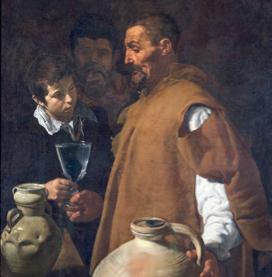
The Waterseller of Seville, c.1620
Painted by Velázquez in his late teens, this work shows the artist’s early talent. The painting can be seen in the newly lit Waterloo Gallery at Apsley House.
EXPLAINED
The Nation’s Toast to the Heroes of World War II

What’s happening to markVE Day?
Over the bank holiday weekend of 8–10 May, events around the country will be taking place to mark VE Day 75 – the 75th anniversary of the end of the Second World War in Europe (see www.veday75.org).
How will English Heritage be getting involved?
All of our sites will be taking part in The Nation’s Toast to the Heroes of World War II at 3pm on Friday 8 May,
in which people are encouraged to raise a glass to those who died or were wounded in the conflict. What else should we look out for?
Dover Castle in Kent (pictured) and Pendennis Castle in Cornwall will be firing their anti-aircraft guns, while all of our sites with cafés will be running a ‘tea at three’ offer, allowing visitors to purchase their brew in a Second World War-style enamel mug. www.english-heritage.org.uk/ve-day
What is Members’ Week and what does it mean for you?
We will be running a special Members’ Week later this year.Throughout the week, Members will be able to participate in a range of exclusive activities, including Members-only events, behind-the-scenes tours and family activities, along with opportunities to see conservation work in action at our sites.There will be a wide geographical spread of events across the week, so there should be something happening near you. We’ll have further details on Members’ Week in the next issue of the Members’ Magazine so look out for it. Members’ Week is supported by Country Life butter. www.english-heritage.org.uk/membersweek

Visit the World of Park & Leisure Homes Show 2020
Agrowing number of people are discovering the wonderful Park & Leisure lifestyle. Whether you’re looking for an affordable bolthole or a luxury home, Park & Leisure’s lodges, log cabins and pods offer the very best in relaxed living. Set in coastal and country locations across the UK, the picturesque parks allow you to spend time in the great outdoors, meet new people and live life to the full. So bring your family, friends and even your dog to the World of Park & Leisure Homes Show 2020 and start living the dream.
The world of pods
A new range of bespoke pods offers the ultimate glamping experience.


Now you can become immersed in nature, while still enjoying home comforts such as a comfy bed, kitchenette and heating. Designed to the highest specification, they make for the perfect UK getaway.
At the World of Park & Leisure Homes Show 2020, you’ll be able to explore a huge display of high-quality lodges, cabins and pods. This outdoor event is the largest of its kind in the south of England, and all of the homes on show are set out to recreate the feel of a luxury leisure village. With industry experts on hand for advice and guidance, visitors can find

out about park sites across the UK and discover the fantastic range of products, accessories and services available – not to mention some great deals.
A great free day out
With free entry, free parking and a complimentary show guide, the World of Park & Leisure Home Show makes for a great day out.
Visit the South of England Showground, Ardingly, West Sussex, RH17 6TL (near London Gatwick). Open 10am–4pm daily. Dogs allowed if kept on leads and under control.
Find out more at: www.parkhomeandleisure.co.uk
South of England Showground, Ardingly Friday 3 to Sunday 5 April
INTERVIEW MATT HAVERCROFT PHOTOGRAPHS CHRIS BOULTON
I’m a poet, programme director, educator and editor. I’m responsible for the Barbican Young Poets programme, I’m the national ambassador for I Know I Wish I Will (a poetry competition for young people aged five to 25), one of my collections is taught on an A-level syllabus and, among other things, I’m currently experimenting with generative text machines as tools for creative writing.
I developed a taste for poetry in my early teens, but it was something I became particularly invested in through my early twenties. I loved the idea of being able to put language to work in powerful ways. Many of the poets I admired were able to offer insight into experiences I didn’t necessarily have any connection to and yet, through their words, their subjects became tangible and real.
It’s great that poetry is enjoying increased popularity at the moment – reaching out to new audiences via YouTube and Instagram (the platforms might be new but the cycle of raised attention in poetry isn’t). There are ways in which the best poems fill very necessary spaces for us, particularly in an age that seems to be characterised by fracture and division. And there’s a way in which the best poetry offers a brilliant balance of the things we have in common and the things that make us unique, packaged in a naked, unadulterated form.
I’m excited by the prospect of delving into English history, interrogating English identity and investigating some of the narratives that contribute to some idea of what Englishness is. I’m also looking forward to exploring specific places to serve as anchors for, or portals to, moments in time and personal experiences, real or imagined. I want to peel back layers of history, yes, but I also want to engage with some sites as they are now.
As resident poet, there’s a lot that I’ll be getting up to. Writing, obviously – there’s a list of sites I’m zeroing in on that’ll form the basis of a body of new work. But I’ll also be engaging a number of other

from left
St Mary in Castro church in the grounds of Dover Castle in Kent; detail of French prisoners’ graffiti, Dover Castle, 1710 – Jacob will be writing a series of poems inspired by our historic sites and their stories Facing page Jacob at Dover Castle – one of our many sites that will be hosting his poetry workshops over the year ahead

poets, creating commissions and launching at least one poetry competition. I’m looking forward to being able to create a series of different workshop experiences for local people at the sites I’ll be focusing on, but also curated opportunities for young writers to travel and respond to sites they might otherwise not know or experience.
I’m glad for the opportunity to do this work as a writer. But it’s not just about my singular perspective. I’m hoping that the end result will manifest as a vision of English identity and history across the ages, pitched forward from a broad range of vantage points. To be able to work with established poets, emerging poets and people who may not consider themselves to be poets at all but can explore some sense of a historical site through poetry – it’s an absolute dream.
Find details of Jacob’s workshops at www.englishheritage.org.uk/events. To participate, email creativeprogramme@english-heritage.org.uk

Stonehenge’s latest exhibition documents visits over the last 150 years through a display of personal photos taken by visitors to the stones. We met co-curators Susan Greaney and Martin Parr to find out more – and reveal the stories behind a selection of the 148 images on display
WORDS RHIANNON BATTEN PHOTOGRAPH OLIVER EDWARDS
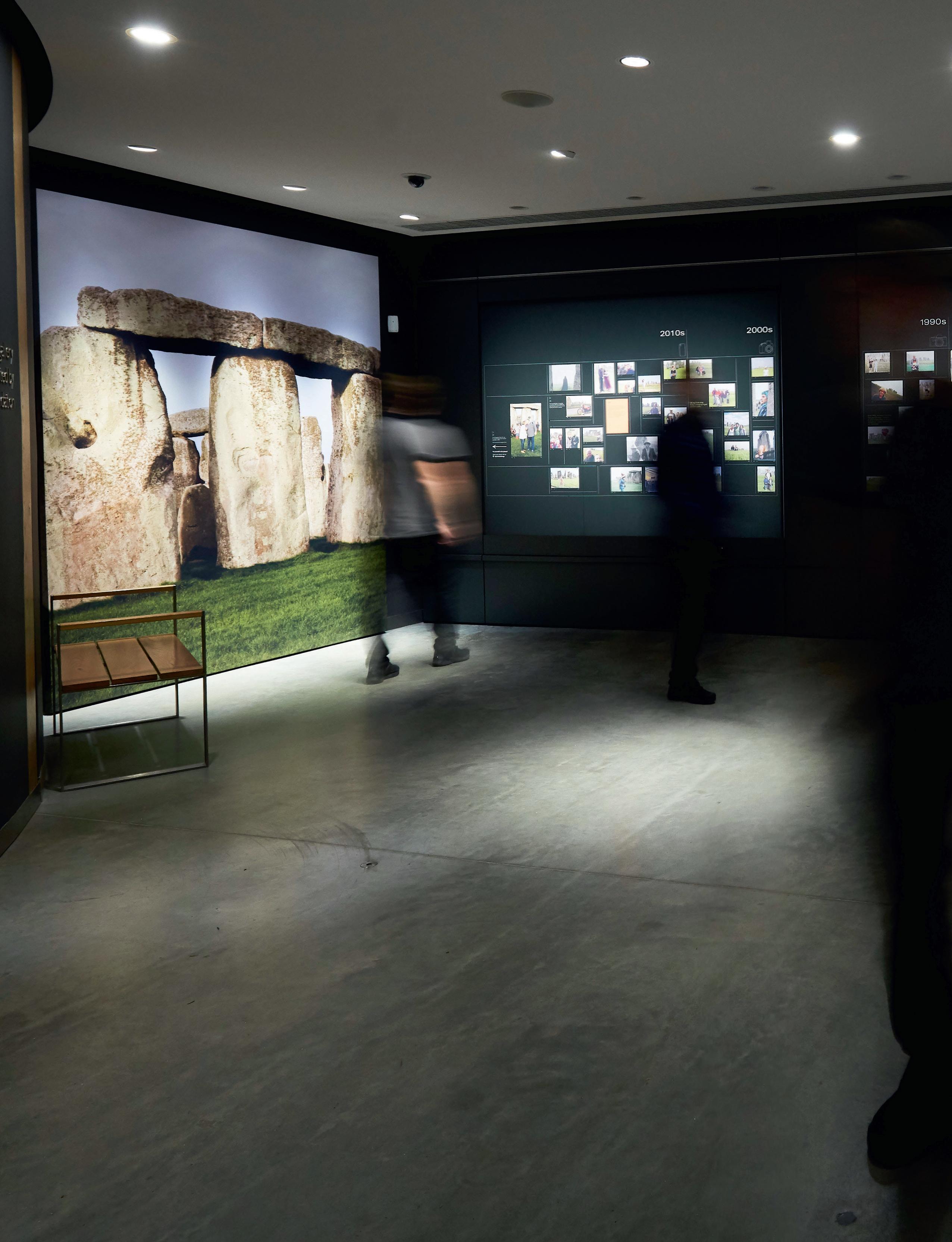
These are not the ethereal, misty photographs of Stonehenge that we’re familiar with. There are no golden hour shots of the famous Wiltshire stone circle or heavy filters applied to the skyline and a complete absence of visitors. In these images people are everywhere – picnicking on the stones, arranging a hand so as to pretend it is holding the stones upright, breezily sightseeing in nothing but a pair of scarlet underpants.
When you realise that documentary photographer Martin Parr is the guest curator of Stonehenge’s latest special exhibition, the scenes are less surprising. He is known, after all, for capturing the absurd in everyday life. But only one of these pictures was taken by Parr – the rest were sent in by members of the public.
Back in 2018, people were asked to send in their snaps of visits to the stones to celebrate the centenary of Stonehenge being gifted to the nation. More than 1,500 were uploaded to the online gallery. This exhibition, ‘Your Stonehenge: 150 Years of Personal Photos’, opened in December, and it showcases 148 of these wonderful photos, taken from 1875 to the present day. Ten of the images have been selected by Parr, the rest by senior properties historian Susan Greaney and curator of collections Dr Ian Leins.
‘The point of this exhibition is to show people engaging with the site, exploring it with friends and family,’ says Greaney. ‘They’re relaxed. They’re having fun. It’s not work, it’s a day out, so people generally have nice memories of being here. People have said to us, “This is the only photo we have of all five of us together, or this was the


day we got engaged.” They’re precious memories of family occasions.’
‘Stonehenge has a role for everybody,’ concurs Parr. ‘People pose in front for different reasons. You have the army posing for a different reason to, say, vegans. That’s what these photos draw upon and that’s what I look for – and for pictures that are strong graphically.’ Having first photographed the site in the 1970s, Parr returned during 2019’s autumn equinox to shoot his own contribution to the exhibition. ‘The great thing about visiting at the equinox or solstice is that you get open access. People can mingle with the stones. And where there are people there are photographs.’
Turn over to discover the stories of a selection of the personal photos on display

In 1975, a month before their wedding, Philip Haines and his fiancée, Louise, visited Stonehenge for the summer solstice. Philip took the photo as the sun was coming up but remembers the event as low-key. ‘There was no music and probably only a few hundred people there. The reason we made the effort is that we weren’t from Salisbury and knew that Stonehenge wouldn’t be on our doorstep forever.’ The tradition has continued in the family: in 2009 the couple’s children, Sarah and Ben, stayed at Stonehenge for the solstice but couldn’t capture the sunrise thanks to the rain.
When Hugh Routh submitted two images of his ancestors enjoying a day out at Stonehenge to the project, it came as a surprise to find that they are the oldest family photographs yet identified. Dating from around 1875, possibly a few years earlier, one image shows the extended family sitting down for what appears to be a champagne picnic. The other (left) shows sisters Isabel and Maud Routh sitting in a carriage, and their brother Robert Sheppard Routh (Hugh’s great-grandfather) standing in front of them with the horse. The Rouths lived at Amport, Hampshire, around two hours away by horse and carriage. Robert’s father, Robert Alfred Routh, was a successful London solicitor. ‘They had money and, I imagine, would have bought a camera as a “musthave” item at that time,’ surmises Hugh. ‘However, the pictures raise more questions than they answer. Why was the family there? Was it a celebration, a birthday party perhaps? Frustratingly, we just don’t know.’

SIBLINGS
JOYCE LEESON
‘I was that small girl on the stone,’ explains Joyce Leeson, née McLaren, whose photograph is one of the most poignant of the exhibition. ‘I was 10 years old when it was taken, in 1941, and the man beside me was my 20-year-old brother, Flight Sergeant Douglas Brian McLaren.’ Douglas was on embarkation leave from the RAF before being posted to Malta to fly Blenheim bombers attacking German warships. He was reported missing, believed killed, the following January. ‘We never saw him again,’ says Joyce. The family lived in Morecambe, Lancashire, but Joyce and her mother were staying on Salisbury Plain during the summer holidays because her father, Captain SR McLaren, an army officer, was stationed there. ‘I do not remember the photo seeming particularly important when it was being taken but, as a small child, it did not occur to me that this would be the last time we would see him. I think it was felt that since Doug was with us for just a few days, we should try to make it a memorable small holiday, and the Stonehenge visit was part of that.’

Dawn Hayles was 17 in 1983 when her father Louis – aka Bristol landlord Dutty Ken – took her to the solstice festival at Stonehenge. ‘I’m on the left in the photo, the girl on the right is my sister Norma’s best friend, and Bumpy is in the middle. Daddy took us to lots of festivals. He was part of a New Age convoy, doing catering (he used to cook Jamaican food such as curry goat, rice and peas, and ackee and saltfish) and Bumpy would do the driving. But this is the festival I remember because of all the people dressed in white doing their thing on the stones. That’s what was going on behind us.’ Dawn and Norma camped out on the road, she says. ‘We just wanted to find a good spot for our sleeping bags and I thought, “This’ll be all right.” We woke up to my dad laughing, saying, “What are you doing in the road?” But it felt so safe there. It was like being among family.’
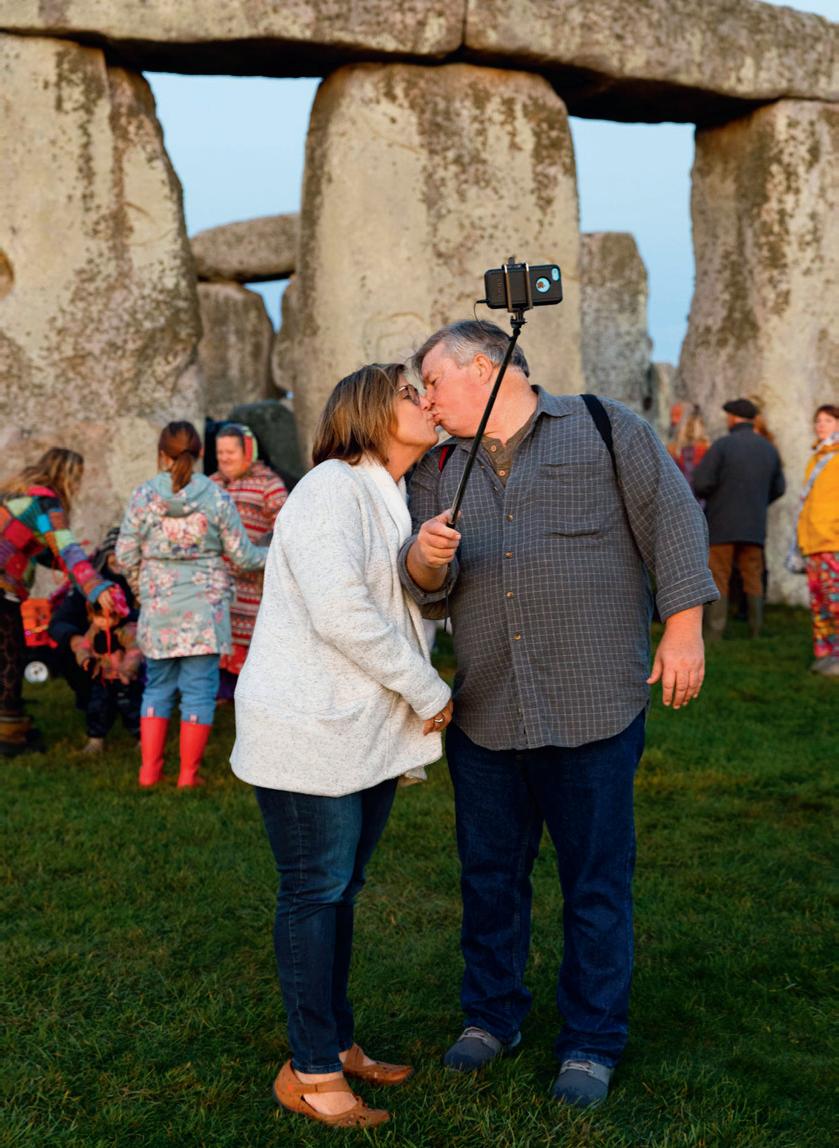


The image Parr took during last autumn’s equinox shows a couple photographing themselves kissing in front of the stones. ‘I’ve been photographing people taking selfies for a couple of years now, so I was on the prowl for that,’ he says. ‘This couple just unfolded themselves in front of me and, bang, I got it.’ But what he didn’t get was the couple’s details and he’s eager to trace them to present them with a signed print.
‘In 2013 I received the English Heritage Members’ Magazine and was taken aback to see myself in it,’ says Richard Woodman Bailey of this 1958 photo, which shows him at Stonehenge as an eight-year-old. In the 1950s, the Ministry of Works decided to re-erect several fallen stones and Richard’s father, TA Bailey, oversaw this work. ‘When the largest stone, which weighed around 30 tonnes, was ready to lower into place, I was given a 1958 penny and told to clamber under and lay the penny in the gap. Health and safety would be apoplectic today!’
SEE THE EXHIBITION
To plan a visit to Stonehenge to see the photos for yourself, go to www.english-heritage.org.uk/stonehenge



As Saxtead Green Post Mill in Suffolk reopens to visitors following the completion of an extensive conservation project, we meet the team tasked with the rescue of this traditional corn mill


Halfway up the 30 steep steps, I asked myself, with my dislike of heights, if I’d made the right decision. Ahead of me rose the imposing Saxtead Green Post Mill, gleaming white in the winter sunshine. At the top of the stairs was the small doorway through which more than 10 generations of millers and countless mill boys had passed. Curiosity to see that ancient workplace of grindstones and grain hoppers urged me on to conquer the staircase’s 60-degree angle and reach the entrance.
Alfred Aldrid, the last owner to work the mill, reckoned that, at the peak of the corn-milling era, 30 other windmills could be seen from the top of that staircase. Saxtead was one of 500 Suffolk mills operating in the 1800s, although that number had greatly dropped by the time the mill commercially ground its last grain in 1947. I stepped inside and inhaled the smell of creosote from the roof repairs, the final part of the restoration and the culmination of 18 months of work for millwright Tim Whiting.
‘Tim is a local millwright, which is a really important thing,’ said national projects manager Joseph James, tasked with overseeing the conservation of this agricultural gem. ‘The Heritage Craft Association has just added millwrighting to its red list of endangered crafts. So we have a duty to protect the millwright’s skills.’
Saxtead Green Post Mill is one of the oldest designs of windmill in Britain, the others being smock mills and tower mills. A post mill is made up of a weatherboard body – the buck – sitting atop an open trestle or brick roundhouse, with an immense oak post running up the middle. A staircase mounted on iron wheels is attached to the bottom of the buck, diametrically opposite the four sails. At the bottom of the stairs a beamed structure supports the fantail, or fly, consisting of six blades. Using only power generated by those blades as they catch the wind, the whole assembly of buck, staircase and fantail rotates around the heavily greased post. The staircase’s wheels run on a track of wood and iron embedded in the ground around the mill.
According to Jonathan Sullivan, grandson of Alfred Aldrid, a mill has been on that spot since 1287. ‘It would have been a post mill in those days, too,’ he said. ‘But it would have started with a pollarded oak tree that they built a windmill on top of. Then, as the technology improved, they cut the oak tree off at the base and propped the mill up higher.’
The increased height accommodated bigger sails to generate more grinding power. It also meant the sails were well clear of the ground and didn’t need to be stopped for wagons collecting the bags of flour. However, raising the mill didn’t include uprooting the track and moving it further out, so the staircase just got steeper.




‘Chances are the millwrights would have used the same tree throughout,’ said Sullivan. ‘Which is why those who know about the age of wood say this post could go back to 1287.’
The mill has been in Sullivan’s family for 146 years. ‘I was showing people round when I was 12. We have English Heritage as guardians but I’ve had a fair degree of input. My grandfather died in 1947 and my grandmother let out the mill for a year, which was the last time it actually ground corn. She died in 1949 and my mother inherited. My father was an electrical engineer, not into milling, but he could see what was happening with mills being demolished. He approached the then Ministry of Works for help with preserving it. Despite being constantly knocked back locally, he persisted, and that’s why it’s here now.’
Saxtead came into our care in the 1980s.
‘It is still owned by the Sullivan family, Jonathan and his brother,’ explained Joseph James, ‘but we are custodians and maintain it. English Heritage oversee the opening of the mill to visitors but it is
SEE A VIDEO OF THE MILL’S RESTORATION www.english-heritage.org. uk/magazine

Lincolnshire’s Sibsey Trader Windmill is next up for conservation
Sibsey Trader Mill in Lincolnshire was built in 1877. It is a tower mill, where sails and fantail are both attached to a rotating cap at the top of the brick structure housing the grinding machinery. It is one of the few six-sailed windmills left in Britain.
The mill is under our care and managed by tenant Ian Ansell. Conservation work over the next two years will be completed by millwright Tim Whiting and overseen by national projects manager Joseph James. The aim is to restore it to full working order and develop endangered millwrighting skills.

‘There’s a major bit of structural engineering to be done because the cap is not fitting right and is jumping,’ said James. ‘We’ve taken off the cap completely and put on a temporary cover. Then Tim will build a new cap along the same lines. We’ll then refresh all internal workings and do brickwork repairs to the tower. We’ll also repair the sails and refix them.
‘She’s a six-sail windmill and six storeys high, so she’s a big girl. The whole project will take a couple of years to complete – we know from our experience at Saxtead that windmills take a long time to restore.’

‘The mill has been owned by Sullivan’s family for 146 years’
great to have Jonathan keeping an extra pair of eyes on things. The project team are indebted to him and his family for their valued support and long history of involvement with the preservation of the mill.’ That experienced eye has been an invaluable help to millwright Tim Whiting, who also remembers the mill from childhood. ‘I grew up in the grounds of Friston windmill [12 miles away] and, after training as a cabinetmaker and joiner, my first workshop was in the old corn store for the mill. I just got immersed in windmills from then on.
‘Originally, we came here in the hope of patching up and replacing the main staircase, which had failed. But, as with everything else, when you start pulling things apart you find more lurking below the surface. The mill was heavily restored in the 1950s by millwright Jesse Wightman, and he did it right.
‘But when you’re looking at something as old as this, the maintenance is ongoing. We’ve put a new roof on and the entire fly frame has been replaced, along with the staircase’s oak carriage. The fly blades are original but we dismantled and rebuilt them. The castings – the cogs that work the wheels – are all original but they’ve been renovated. Luckily the canvas shutters on the sails were in a reasonable condition so we’ve only had to replace a few.’
Refreshing the paintwork proved a particular challenge. Lead paint was originally used at Saxtead and a 2m-high layer of coal tar was used on the outside of the roundhouse to waterproof the brickwork. ‘The roundhouse has just been topped up
with possibly its last coat of coal tar,’ said Whiting. ‘It’s getting harder and harder to find. I was literally down to the last yoghurt pot-worth I had in stock.’
Sourcing appropriate materials and crafting replacement parts has required suppliers and skills that are in short supply. Whiting trained in traditional joinery and had to learn specialist metalwork. ‘You do it on the job,’ he said. ‘In the old days I would still be the apprentice. Traditionally it was 15 years before you could call yourself a millwright. I’ve been doing it since 2011 but I was lucky to work for five years with the absolute master: Vincent Pargeter. He was the millwright and had respect across the planet for the mills he restored.’
Saxtead’s more recent £250,000 conservation began when the existing structural staircase was becoming unsafe. The replacement of all elements of working mills is a standard method of maintenance and conservation, and the staircase will have been replaced a number of times during the life of the mill. So, after temporary structural repairs to make things safe, the project team was brought together to replace the staircase on a like-for-like basis. It was then decided that, in order to safeguard the mill for the future, the scope of the project should grow to include a new set of sails and stocks, and repairs to the buck house and fantail at the rear of the mill. With the mill being located so close to his family home, Jonathan Sullivan was particularly glad to see the repairs underway. ‘We knew we had problems in Storm Doris in 2017 when I saw the buck rocking. If you look at the mill side-on, you’ll

see the windows are more towards the front than the back, and they are in line with the post. The weight of the buck on one side counteracts the weight of the millstones and sails on the other. So that’s why it’s perfectly balanced.
‘If you add all the timber together, two sets of millstones and the sails with shutters on, it’s probably 40 tonnes. It’s safe if it’s properly maintained but in Storm Doris the staircase was groaning.’
With those vital repairs over and the last bit of paint applied, the mill was fit to be ‘let go’ at the end of 2019. ‘We’ll leave it to wind,’ said Whiting. ‘Winding is when the fly on the back spins so the whole mill can turn. We’ll leave the mill winding for as long as we can, to prove itself, and then we’ll load all the shutters back into the sails. It’ll be completely ready in the spring for the reopening.’
Saxtead Green Post Mill has survived more than 700 years and, with care, could last another 700 and beyond. As Joseph James said, ‘It’s a symbol of the countryside. It’s our history and it’s important that we remember and keep that alive.’
In 1948, Pathé News made a film about Saxtead in its last days as a working mill. The film ended with words that must be echoed by everyone who has worked on its conservation: ‘This fine old mill near Woodbridge in Suffolk defies the passing of the years, beautifying the face of Britain.’
To plan your visit to Saxtead Green Post Mill in Suffolk, and for more information on the site, go to www.english-heritage.org.uk/saxtead




Norse invaders came to Holy Island in AD 793. This was their first significant attack in western Europe and its terrifying nature was widely reported across the continent. Neither the faith of the inhabitants nor the power of St Cuthbert, their saint, had been able to protect one of England’s holiest sites. Might this enigmatic stone, carved a few years later, record the disaster? It was almost certainly a grave marker, but its imagery of warriors with swords and axes suggests it was more than simply a memorial. On the other side are praying figures: possibly a scene of the Apocalypse. Yet perhaps the carving drew attention to Christ’s warning not to interpret every battle as a sign of the coming of the Last Judgement. As such, we may read a deeper response to the event: a symbol of defiance and resilience. This stone was seemingly lost to time, along with the original monastery. Yet the monastery was refounded in the early 12th century and visitors can now make a pilgrimage there, with the stone among the artefacts taking centre stage.
To plan a visit to Lindisfarne Priory in Northumberland to see the Viking Raider Stone, go to www.english-heritage.org.uk/lindisfarne







Three of our experts reveal the English Heritage properties that played their part in changing the course of English history, from military victories and technological breakthroughs to social shifts and political milestones

THE EXPERTS

Dr Dominique Bouchard
Head of learning and interpretation

What happened here? The roots of English Christianity were planted
In 597, Augustine arrived in south-east Britain, charged by Pope Gregory with converting the pagan King Æthelberht of Kent, the most powerful of the AngloSaxon monarchs. That task completed, the following year Augustine founded the abbey – originally dedicated to St Peter and St Paul – which became the cradle of revived English Christianity. ‘This site speaks of a very big theme, a very big process in history – the conversion of the pagan kingdoms of England to Christianity,’ says head historic properties curator Dr Jeremy Ashbee.
Dr Steven Brindle
Senior properties
historian
‘What Augustine’s settlement did was to start a tradition of literate clerics living in England,’ agrees senior properties historian Dr Steven Brindle. ‘You could almost say it was the start of recorded history, not in these islands, but of the English people.’ Today, you can roam the ruins of Norman and later medieval structures built on the site of Augustine’s original abbey, and spy remnants of Anglo-Saxon structures in the atmospheric grounds. www.english-heritage.org.uk/ staugustinesabbey

What happened here? The modern English parliament was shaped
Built between 1246 and 1255 on the orders of King Henry III, the Chapter House was ostensibly a present for the Benedictine monks of the adjacent abbey – but that was not the monarch’s primary objective. ‘We now think that his motivation was much more tied to the idea of parliament,’ says Jeremy Ashbee. ‘He was creating the grand assembly room where he would appear in his full kingly state and speak to the nation.’ The origins of the English parliament have long been debated, but it’s clear that the design of this building was connected with the way Henry planned to conduct such meetings. www.english-heritage.org.uk/chapter-house

Dr Jeremy Ashbee
Head properties
curator


What happened here? Duke William launched his conquest of England
Every student knows about the pivotal clash at Hastings on 14 October 1066. But it was at Pevensey Bay, 10 miles south-west of the battle site, that the Norman Duke William landed his troops on 28 September, establishing his base camp before marching off to face King Harold II and his Anglo-Saxons. ‘At Pevensey, you can still see things William would have seen,’ says Jeremy Ashbee. ‘You can see why William, having landed there, would say: “This is where we’ll camp for the first night.”’ Pevensey remained important after William’s invasion, and today you can admire the remains of the mighty Norman keep and gatehouse built after he had secured his crown. www.english-heritage.org.uk/pevensey
What happened here? Lord Mansfield deliberated a case that played a key role in the abolition of slavery
This grand neoclassical villa is now a familiar landmark on Hampstead Heath, admired as a wonderful example of the work of 18th-century architect Robert Adam, and for its fine art collection featuring several Old Masters. But Kenwood is arguably most important as the home of William Murray, 1st Earl of Mansfield, portrayed by Tom Wilkinson in the 2014 film Belle. In 1772,
Mansfield – then Lord Chief Justice of the King’s Bench – ruled on the case of Somerset vs Stewart, brought on behalf of an enslaved African man detained after escaping in England. ‘Mansfield’s judgment declared that there was no basis in common law for slavery,’ says Dr Dominique Bouchard, head of learning and interpretation, ‘and was a fundamental
part – certainly an important legal step –in the abolition of the slave trade.’ Though it was another 35 years before the slave trade was abolished by the UK parliament, the contribution of Mansfield’s judgement is clear, asserting of slavery that, ‘It is so odious that nothing can be suffered to support it, but positive law.’
www.english-heritage.org.uk/kenwood



What happened here? Abraham Darby III kick-started the Industrial Revolution
Admiring the graceful semicircle of the Iron Bridge reflected in the River Severn, it takes a degree of imagination to picture this site surrounded by forges and factories. Just two centuries ago, that was the scene greeting visitors to Coalbrookdale, heartland of ironmaking in England. Its apogee survives in the form of that 30m-long arch, completed in 1779 by Abraham Darby III, whose grandfather perfected coke-fuelled iron smelting 70 years earlier. ‘This was the moment at which iron went from being something used at the scale of a blacksmith’s forge to a structure spanning a major river,’ explains Steven Brindle. ‘This was the first bridge to be made entirely of iron in world history; a great landmark in the development of Britain.’ Today, as well as crossing the bridge itself, visitors to Coalbrookdale can explore an extensive roster of fascinating museums. www.english-heritage.org.uk/ironbridge

What happened here? The way Britons think about war and remembrance changed
The most striking thing about Sir Edwin Lutyen’s monument in Whitehall is its simplicity. The white Portland stone column bears only carved wreaths, a symbolic tomb and three words: ‘The Glorious Dead’. ‘Its construction changed the way that people across the UK think about remembrance and war,’ says Dominique Bouchard. ‘There are really wonderful photographs from the peace day parade on 19 July 1919, showing thousands of soldiers returning from war walking past the Cenotaph; I think it was a transformational moment in terms of the country’s psyche.’ The original monument, constructed with wood and canvas, was only temporary – but the powerful public response prompted the construction of Lutyen’s permanent replacement, completed in time for the Armistice Day parade in 1920. www.english-heritage.org.uk/london-wwi-memorials

What happened here? Darwin revolutionised our understanding of evolution
When the renowned naturalist first set eyes on this property in the Kent countryside in 1842, he was underwhelmed by its aesthetic charms; Darwin wrote that it was ‘ugly… neither old nor new’. But Down House provided what he most needed at that time: space to think – and his thinking during his 40 years living here proved pivotal to modern biology. ‘This was where he wrote all of his books, including On the Origin of Species, published in 1859,’ says Steven
Brindle. ‘Darwin used the garden and the landscape around him as a kind of open-air laboratory. The observations he carried out here were as important as those he’d carried out while a naturalist on board HMS Beagle in the 1830s.’ Today, you can visit the study where he wrote that groundbreaking work, explore his family’s rooms and greenhouse, and stroll through the gardens where Darwin paced while formulating his theories. www.english-heritage.org.uk/downhouse
LISTEN TO THE FULL DEBATE ON EPISODE 40 OF OUR PODCAST www.english-heritage. org.uk/podcast

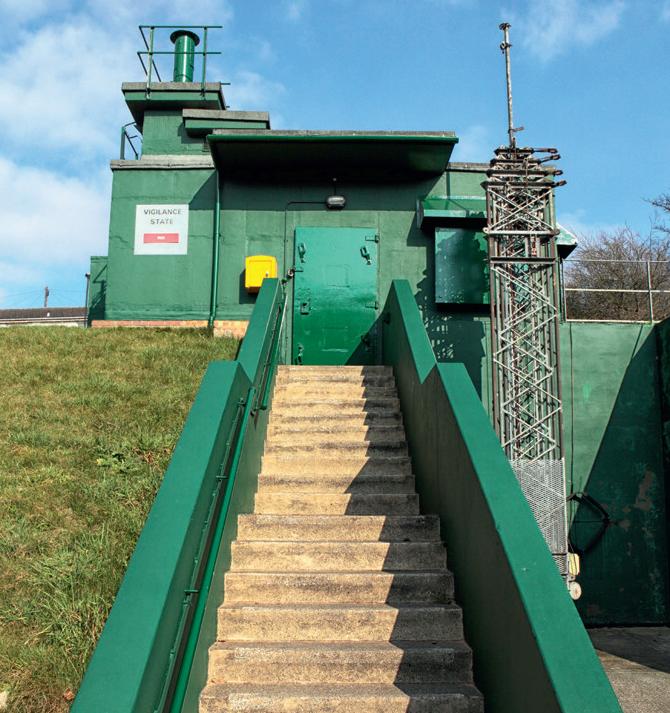
What happened here? Real people prepared for nuclear attack and its immediate consequences
What happened here? The evacuation of British and allied troops from Dunkirk during the Second World War was coordinated
This spot has been fortified for many centuries, probably since the Iron Age, and you can still admire its Roman lighthouse, Anglo-Saxon church and the tower of Henry II’s 12thcentury palace. But it’s what lies beneath that has arguably been most significant historically. A warren of tunnels was excavated during the Napoleonic Wars and extended during the Second World War, when they housed the command centre that controlled naval operations in the Channel. ‘In that pivotal moment of 1940, when Operation Dynamo –the Dunkirk evacuation – was organised from there, Dover symbolised Britain’s defiance of the Third Reich,’ says Jeremy Ashbee. Dover’s tunnels now offer an immersive experience for visitors, who can learn about the planning of the rescue operation from Dunkirk. www.english-heritage.org.uk/dover
One of our most modern sites is also one of our most chilling. ‘In a sense, nothing happened here but it was built in anticipation of national and worldwide disaster,’ says Dominique Bouchard. ‘This was where the Royal Observer Corps would have been stationed. In the event of nuclear attack or fallout, they would have taken readings of the radiation outside the bunker. Readings from around 40 tiny bunkers across Yorkshire would have been collected and sent to UK Warning and Monitoring Organisation for analysis and passed to civil and military authorities.’ It’s a surprisingly human place to visit, too. ‘People would have said goodbye to their families and headed for the bunker, while their homes outside might have been destroyed and their families perished, depending on the proximity of the nuclear attack. It’s not hard to imagine yourself being one of those people, and to think about what that must have been like. The bunker has a really tactile aesthetic and it’s full of things we recognise, yet it tells a really harrowing story of what might have been.’
www.english-heritage.org.uk/ york-cold-war-bunker
READ MORE ONLINE Go to our website to read more nominations from our experts on the sites that changed the course of England’s history. www.english-heritage.org.uk/magazine



Discover the beauty of Kvarner Bay & Istria aboard the Queen Eleganza 30th May to 7th June, 21st to 29th June, 16th to 24th July & 21st to 29th August 2021

For those who enjoy cruising amongst some of the world’s most beautiful coastal scenery, swimming in calm blue waters and exploring Medieval harbours and picturesque villages with a small group of like-minded travellers, our eight night journey along the Istrian coast will surely appeal. With just 36 guests on board, the Queen Eleganza has the advantage of being able to dock centrally in towns and call into secluded bays and hidden coves enabling us to explore parts of the Istrian coast that passengers aboard the large cruise ships in the region rarely get to visit.
As we make our way along the coast we will witness a range of scenic delights including the charming island of Mali Losinj, the fascinating Brijuni Islands and the ancient town of Porec. Whilst in Pula, we will visit one of the best-preserved Roman amphitheatres in the world and the strong Venetian influence on the region will be evident during our exploration of Cres. We will also travel inland to an area of disarming beauty characterised by fertile valleys with hilltop villages. Here we explore the village of Motovun, in the middle of truffle territory, which has arguably the best views of the Istrian interior from its ramparts.
Istria is often acclaimed for its gastronomy and we will enjoy some lunches ashore to experience the local cuisine as well as a visit to a vineyard to taste the wines typical of the area. In addition to our included guided excursions, we have allowed ample time at leisure and there will also be opportunities to swim from the ship and, taking advantage of our central moorings, to dine ashore and experience the atmospheric ports in their evening splendour.
For these voyages we have chartered the 36 passenger Queen Eleganza, one of the finest Croatian flagged vessels of her kind. Launched in 2018 it is the perfect ship to escape the formalities of larger vessels and enjoy the casual nature of small ship cruising along the most beautiful of coastlines. The 18 cabins are finished to the highest standard and are equipped with an en-suite bathroom with shower, safe, air conditioning/heating, hairdryer and flat screen TV. The vessel has been designed with spacious outside public areas including a large Sun Deck with an excellent shaded area. Whether you choose to spend your time indoors in the lounge or bar area, or in a comfortable lounger on the Sun Deck, the ship has many perfect spots from which to relax and watch the passing scenery. Meals served on board feature wholesome and fresh Mediterranean cuisine and, when dining ashore independently, your knowledgeable Cruise Director will recommend popular local restaurants.




SHIP CRUISING WITH NOBLE
SPECIAL OFFER – SAVE £200 PER PERSON


Day 1 London Heathrow to Opatija, Croatia. Fly by scheduled flight to Zagreb and transfer to the Queen Eleganza in Opatija. After settling into your cabin, enjoy welcome drinks and dinner. (D)
Day 2 Rab. We sail during breakfast for the island of Rab. This afternoon we will enjoy some time at leisure and an early evening guided walk through the picturesque Old Town, a perfectly preserved late Medieval Adriatic settlement squeezed into a slender peninsula along which are dotted a sequence of Romanesque campaniles. We have the opportunity this evening to dine ashore and sample one of the many local restaurants and we will remain moored overnight in the harbour. (B, L)
Day 3 Mali Losinj. Spend a relaxing morning on board as we sail to the island of Mali Losinj which sits at the foot of a protected harbour on the southeast coast of Losinj Island. It is the island’s mild climate and rich flora that gave Mali Losinj its reputation as one of the most fragrant islands in Croatia; its air is scented with lavender, sage and rosemary. The seafront of old town Mali Losinj is lined with a string of

imposing 19th century houses and villas. Dine ashore tonight in this stunning location. (B, L)
Day 4 Cres. During breakfast we will cruise to the nearby island of Cres, mooring in the sheltered scenic Medieval harbour at Cres Town. Enjoy a walk through the atmospheric streets which have a strong Italian feel having been under Venetian rule in the 15th and 16th centuries. After a lunch of local specialities at a traditional restaurant we will continue to the former fort city of Lubenice. Situated on a cliff 378 metres above the sea we will explore the fortress, city gates, houses, chapels and winding streets of this evocative site and enjoy the stunning views over the bay below. Dine ashore this evening and perhaps take a stroll along the seaside promenade. (B, L)
Day 5 Pula. Today we arrive at the tip of the Istrian Peninsula and the former Roman settlement of Polensium, now known as Pula. During our afternoon tour we will discover one of the best preserved Roman amphitheatres left in the world. The Arena, built in the 1st century AD was designed to host gladiatorial contests with seating for up to 20,000 spectators. Enjoy dinner on board tonight. (B, L, D)
Day 6 Brijuni Islands & Porec. The 14 islands of the Brijuni comprise one of Croatia’s National Parks and were once the summer retreat of former Yugoslav leader, Tito. We will explore Veliki Brijun including the 1st century Roman Villa, the nine hectare safari park created by Tito to house the exotic animals gifted to him by world leaders and the Church of St Germain. Later, we will sail up the Istrian coast to Porec where we will discover the compact old town on a walking tour and visit the 6th
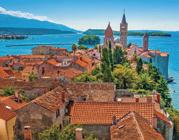

century Euphrasian Basilica. Enjoy dinner ashore tonight. (B, L)
Day 7 Motovun & Momjan. Today we will travel to the Istrian interior, an area famed for its picturesque villages, vineyards and forests that produce Istrian white truffles. On a morning walking tour we will explore Motovun with its RomanesqueGothic bell tower, the Renaissance Church of St Stephen designed by Andrea Palladio and the charming central square. After a lunch of local specialities we will head into the agricultural area around Momjan where some of Croatia’s finest olives and vines have been grown for thousands of years. We will visit a local vineyard and enjoy a tasting of the Muscat and Malvasia wines
which are typical of the region before sampling the olive oil. Return to the ship for dinner on board. (B, L, D)
Day 8 Rovinj. Sail today to the atmospheric town of Rovinj where the houses inside the old town are small and lean in to each other creating a unique atmosphere. Our guided walking tour will include a visit to the town’s main landmark, St. Euphemia Church, which is built on the top of a small hill. Return to the Queen Eleganza for our farewell dinner on board tonight. (B, L, D)
Day 9 Rovinj to London Gatwick. Disembark this morning and transfer to Pula for our scheduled flight to London Gatwick. (B)
Special offer prices per person based on double occupancy start from £2695 for a category 1 cabin. Cabins for sole use from £2495
Economy class scheduled air travel • Eight nights aboard the Queen Eleganza • Meals as indicated (B-Breakfast, L-Lunch, D-Dinner) •Wine, beer & soft drinks with included lunch and dinners • Shore excursions • Noble Caledonia Cruise Director • Gratuities • Transfers.
NB: Ports & itinerary subject to change. All special offers are subject to availability. Travel insurance is not included in the price. Our current booking conditions apply to all reservations.
In the first of our four Voices of England essays, English Heritage trustee Professor Ronald Hutton reveals the role of pre-Christian beliefs in shaping our landscapes, landmarks and language
WORDS PROFESSOR RONALD HUTTON ILLUSTRATION ALAN KITCHING


The pagan heritage of England consists of the material remains of the pre-Christian religions which were practised in this land over 35 millennia. These remains are a precious resource for inspiring the modern imagination, to create music, art and literature of all kinds, and to define personal spirituality, either in sympathy with ancient places, images and ideas, or against them. It is perhaps the richest and most diverse such heritage in Europe.
It is also one of which our knowledge is constantly increasing – and this is especially true of the most distant periods of human activity, the Old Stone Age (or Palaeolithic) and the Middle Stone Age (or Mesolithic). Only in 2003 was it realised that the caves at Creswell Crags on the Nottinghamshire-Derbyshire border contained one of the finest collections of Palaeolithic carvings in the world; and only in the 2010s was the true size and importance appreciated of Starr Carr, a Mesolithic settlement in Yorkshire at which offerings were thrown into a neighbouring lake, and ceremonial headdresses worn.
Really, however, the construction of impressive ritual monuments only began 6,000 years ago, with the arrival of the New Stone Age (or Neolithic) in the British Isles. This brought farming (both in the cultivation of crops and herding of livestock), pottery, and polished axe heads that could fell trees. By clearing the landscape for fields and pastures, humans seem to have realised that they could alter the land in another way as well: by raising ceremonial structures which would dominate the landscape and last as long as the land itself, if not destroyed by other people.
The first widespread class of monuments built in the Neolithic – which was also the earliest of the entire human race – consisted of chambers of big stones or timbers, usually covered with large mounds which stood out in the landscape and restricted entry to the chambers. In England those mounds are generally called long barrows. At times the chambers were left standing uncovered like great stone boxes, and these are usually known as dolmens. Most such monuments contained human bones, so were shrines of a religion at least partly mediated through the dead. Such structures were built all around the western seaboard of Europe, from Spain to Denmark, between 4500 and 3000 BC.
English Heritage cares for some of the finest long barrows, of which Wayland’s Smithy in Oxfordshire and the West Kennet one in Wiltshire are the most famous. Their mounds were made of chalk or limestone rock, so would have shone white or golden when new. Some of the most impressive dolmens, from Kit’s Coty House in Kent

to Trethevy Quoit in Cornwall, are also in English Heritage’s guardianship.
In the advent of the third millennium BC, the British became fascinated by round shapes, and blocked up the old chambers to worship instead in circular enclosures made of earthen banks, timber posts, standing stones, or sometimes of all three. The stone circles are mostly what survive to this day, from Castlerigg, set majestically amid the Cumbrian mountains, to the Hurlers on the edge of Bodmin Moor, not to mention the most celebrated and spectacular of all: Stonehenge. Here, uniquely, the Neolithic builders shaped the dolmens like huge pieces of wood, with polished sides and mortice and tenon joints, to create an imitation of a timber circle in stone. These circular sanctuaries were not merely open to the sky but sometimes aligned on heavenly bodies – Stonehenge being orientated on the midsummer sunrise and midwinter sunsets, so that thousands of revellers still gather there at those times today. The honoured dead were no longer put into communal shrines, but sealed, with precious goods, under smaller circular mounds – called round barrows –many of which can be seen around Stonehenge.
The sacred circles were built between about 3000 and 1500 BC, in which time metal technology was adopted, and Britain passed into the Bronze Age. When they fell out of fashion,
there was a gap in monument construction of several centuries, and then people began again to gather for worship in open-air enclosures formed of single or multiple banks and ditches, which often hugged the contours of a hilltop or ridge.
We used to call these things hill forts, and think of them as noble strongholds similar to medieval castles. It now seems that they were assembly places where farming families would meet seasonally in large numbers for fairs, festivals, legal proceedings and religious ceremonies – all those which have been excavated contained shrines. These great structures became the classic monuments of the Iron Age into which Britain moved around 600 BC, and English Heritage looks after some of the best preserved, including the largest of all – Maiden Castle in Dorset – which spans 120 acres.
In AD 43 the Romans arrived and conquered most of Britain, including all of what is now England. They introduced stone-built classical

Professor Hutton is an authority on history of the British Isles in the 16th and 17th centuries, on ancient and medieval paganism and magic, and on the global context of witchcraft beliefs
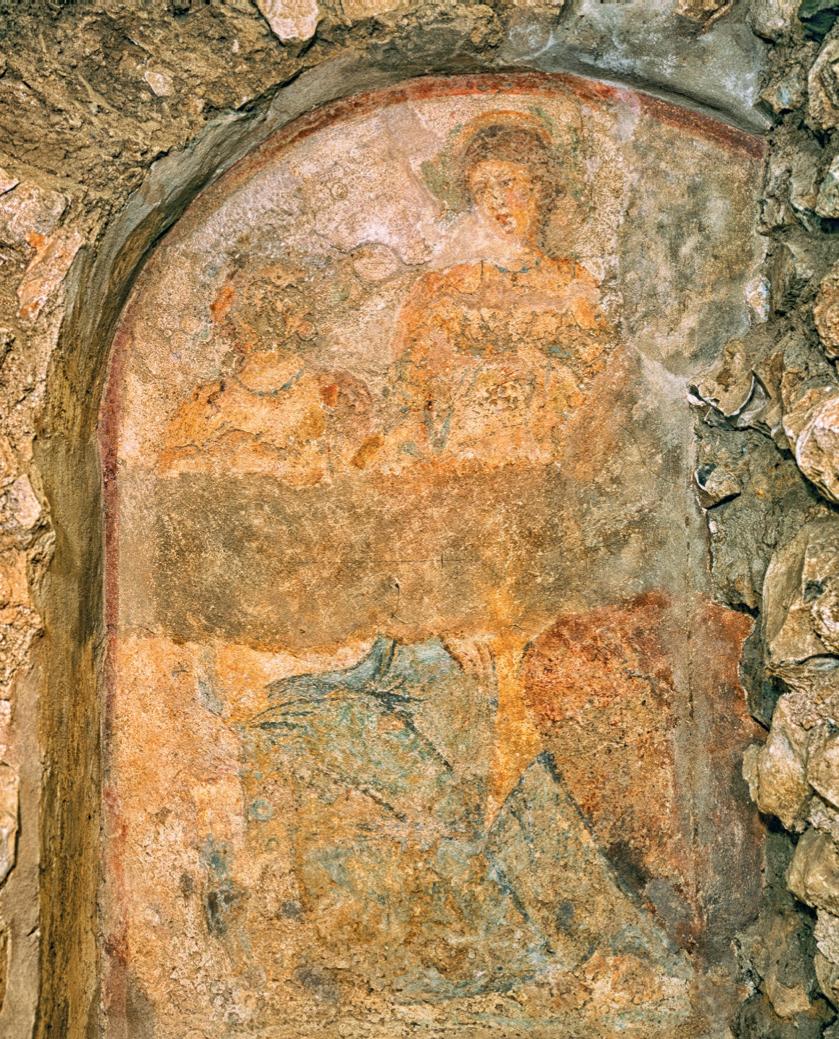

temples, the representation of gods and goddesses in carvings and statues, and the recording of offerings to them in inscriptions. These remains reveal the names and identities of many of the native deities, often with beautiful names such as Belatucadrus, Cocidius, Conventina and Ollodius. In addition, however, Roman rule introduced pantheons of divinities from all over the empire, as foreign soldiers and traders arrived in Britain.
The goddesses and gods of Egypt, Syria, Greece, Italy, Spain and all the northern provinces arrived and were given temples, shrines and honours. Sometimes they were paired with native equivalents, so that Mercury, Roman god of commerce, married Rosmerta, Celtic goddess of abundance. Images of and dedications to these many deities can be found in forts on Hadrian’s Wall and the civilian town of Corbridge to the south of it, the city of Wroxeter, the roadside station of Wall in Staffordshire, and a set of villas in the south of England.
The Romans also brought Christianity (and some of the earliest traces of that in Britain were found as lovely wall paintings, such as those at Lullingstone Roman Villa in Kent). By the fourth century that was starting to take over Britain, but it received a check in the following 200 years when pagan Anglo-Saxon newcomers occupied most of the former Roman province and gave it the name of England. They brought their own Germanic deities such as Woden, god of war and wisdom; Thunor, deity of farming and the weather; and Frigg, goddess of love or fertility. Their shrines – where they existed at all – were small and flimsy wooden structures, but they
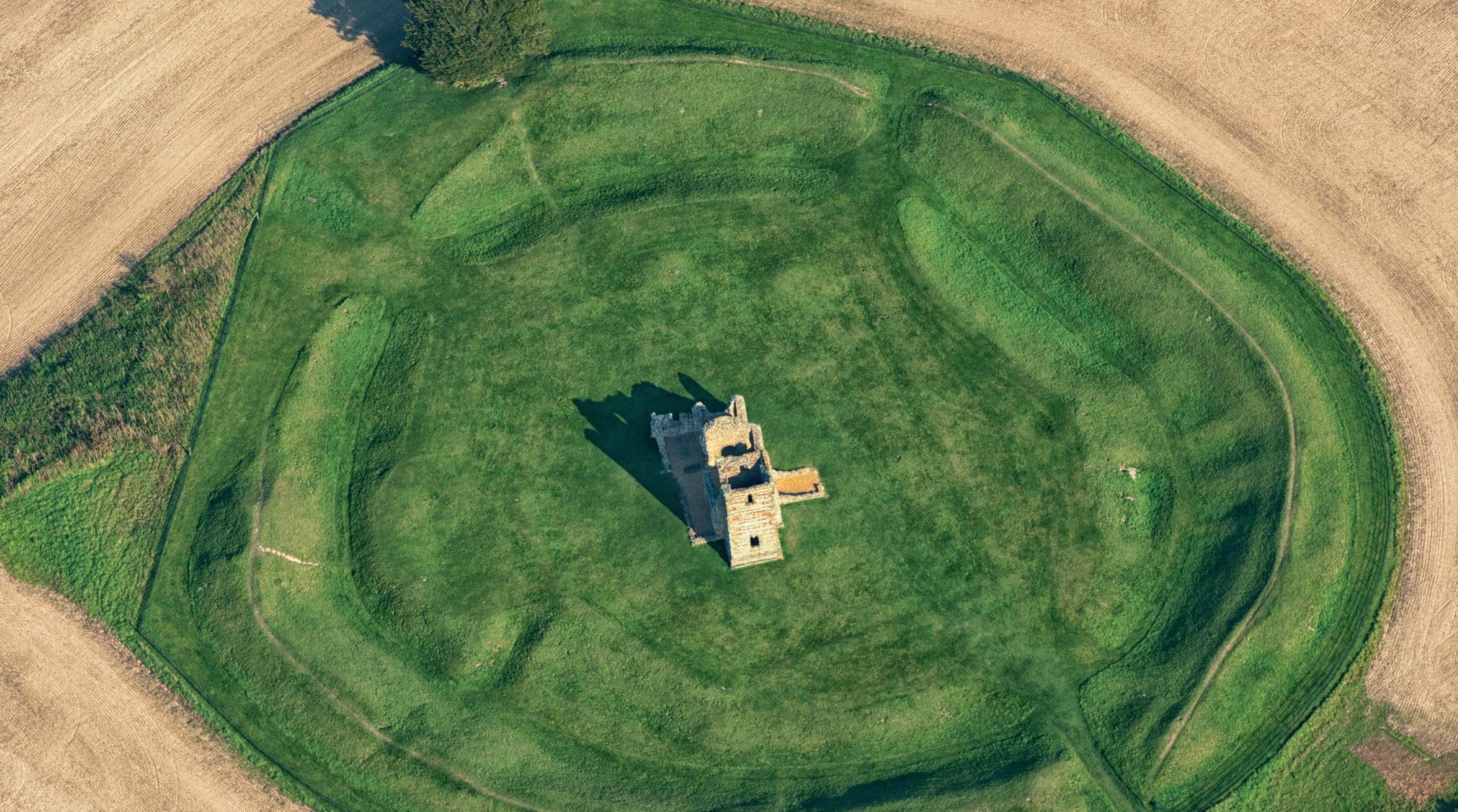
have left their names in the days of the week, as Wednesday, Thursday and Friday, along with place names such as Wednesbury and Thundersley. When the Anglo-Saxons were converted to Christianity in turn, in the seventh century, they enjoyed only just over 100 years of security before more pagan invaders arrived from the north.
These were the Vikings, and with them came their own Norse pantheon which was essentially the same as that of the Anglo-Saxons with slightly different names, so that to them Woden, Thunor and Frigg became Odin, Thor and Freya. Only when they were converted in turn – a process not complete until the late 10th century – could England be said to have finally abandoned paganism, leaving a powerful legacy of characters, images and monuments to inspire the creative imagination ever since.
The most significant feature of that legacy is its extraordinary complexity and variety. If you are an inhabitant of most of the rest of northern Europe, from Iceland and Ireland through Scandinavia, the Netherlands, Germany and the Baltic States to Finland and Russia, there is one pantheon of ancient pagan deities to whom the historical memory of your particular nation refers: respectively that of the Irish, Scandinavian, Germanic, Baltic or Slavonic
goddesses and gods, according to your area. Likewise, if you are a modern Greek, it is the Olympian deities to whom your imagination turns – Zeus, Athene, Aphrodite and their fellows – and if you are a modern Italian, to their Roman equivalents, Jupiter, Minerva, Venus, and the rest. In most of these nations there are only one or two kinds of ancient ceremonial monuments that survive to be cared for by national authorities.
In England, however, we have represented on our soil the divine beings of the Egyptians, Syrians, Greeks, Africans, Italians, Spaniards, Gauls, and the other ancient peoples of the Rhine and Danube valleys, plus the Germanic pantheon of the Anglo-Saxons, the Scandinavian one of the Vikings and the local deities of the Iron Age British, revealed in the Roman province. Before all these, we also have three great periods of impressive prehistoric monuments. It is an extraordinary inheritance, of which to be proud and which to preserve and augment for the future.
To learn more about the story of England and our Voices of England events, go to www.english-heritage.org.uk/voices-of-england

Following the acquisition of a diary kept by an 18th-century gardener at Audley End House in Essex, we reveal the other notebooks and letters helping our curators to unearth hidden stories of the people who lived and worked at our sites
WORDS ELLIE CAWTHORNE PHOTOGRAPHS NICK SHAW

In September 2019, curator Peter Moore was given a tip-off. A contact of his had spotted something on an online auction he believed Moore might find interesting. The object in question was a small diary with a mottled brown cover. Inside, entries had been inked in neat lines of intricate handwriting. Dating from the 1790s, it belonged to Thomas Challis, a gardener at Audley End in Essex. As one of the curators working to bring new objects into Audley End’s collection, this was an exciting discovery – Challis’s diary promised to shed much-needed light on the workings of the estate’s gardens in the 18th century. But there was a catch: only five days remained until bidding ended.
After securing some crucial funding from a local supporters’ group, the Friends of Audley End, Moore sat at his laptop, preparing to bid as the clock ticked down. ‘It was tense,’ he says. ‘I left it to the last possible moment to make sure we got it.’
His last-minute bid was successful and the gardener’s diary became the latest addition to a valuable collection of historical documents cared for by English Heritage. From cookbooks and gardening manuals to diaries and personal letters, it’s a varied and colourful range of material helping to bring the stories of our historic properties to life.
I headed to Audley End to see the most recent acquisition and learn more about what it can tell us about life there. Armed with a torch and an impressive set of keys, Moore guided me through the locked-up house to the library, where the manuscript was being photographed for digitisation, in order to make it accessible to as many scholars and members of the public as possible. This is just one stage of a detailed acquisitions process, in which the manuscript will be carefully studied to analyse its historical content and assess the best conditions for its conservation.
Looking through Thomas Challis’s diary, it’s easy to see why Audley End’s curators were so eager to acquire it. Challis was just 16 when he joined the estate as a gardener in 1793, and clearly an enthusiastic employee. His journal is a meticulous record of his work in the kitchen gardens, with entries documenting his daily tasks, from sowing cucumber seeds and planting potatoes to ‘little odd jobs’. Notes and transcripts from contemporary gardening tracts fill the second half of the journal and inside the back cover is an inch-perfect drawing of a glasshouse. Moore plans to display it later this year alongside another gardener’s diary from the 1870s belonging to William Cresswell and a work log belonging to one of Audley End’s current trainee gardeners.
‘What’s fascinating is that even though Challis was working more than 200 years ago, the garden work he describes is not that different from what


happens today in terms of the variety of produce,’ says Moore. Indeed, Challis’s diary entries reveal a rich array of fruit and vegetables that were grown, including melons (or ‘milons’ as he called them), plums, pears, cherries, asparagus, apricots and nectarines. He even mentions picking a brace of pineapples: a prized delicacy in the 18th century. For Audley End’s gardening team –whose kitchen garden is still incredibly productive – studying the diary in detail offers a unique opportunity to gain a better understanding of the practices of their predecessors.
‘When people think of the collections of aristocratic houses like Audley End, they tend to think of fine art and highly decorative objects,’ Moore tells me. ‘But there’s often a different focus now. We also want to acquire things that have an association with those who lived and worked here, especially rare personal artefacts such as diaries. Hundreds of people worked on estates like Audley End, and these kinds of documents help you to see the house through their eyes.’
Darwin’s notebooks and diaries
Historical documents are not only illuminating about working life at properties. Indeed, personal manuscripts have played an equally important role in revealing the secrets of some of history’s most famous figures. At Down House in Kent, the former family home of Charles Darwin, visitors can view the naturalist’s notes from his 1831–36 journey around the world on HMS Beagle. According to senior properties historian Steven Brindle, Darwin’s weighty scientific journal and 18 tiny, scribbly notebooks from the voyage are not only the most precious items in Down House’s collection, but ‘among the most significant objects in the history of science’. This is because ‘they show Darwin’s intellectual journey of discovery and engagement with the natural world,’ says Brindle, offering ‘a vital record of the beginning of a process that eventually culminated in the publication of Darwin’s On the Origins of Species (1859).’
Darwin isn’t the only famous Victorian whose personal writings have provided valuable insights. At Osborne, Queen Victoria’s beloved retreat on the Isle of Wight, the queen’s journals revealed the intricate routines of royal life. These have now been digitised by the Royal Collection Trust and made available online. In 2019, English Heritage’s historians and curators used them to inform an exhibition on royal birthdays, which Victoria and Albert celebrated at Osborne. The journals offer tantalising details that bring the atmosphere of these days to life, from reports of a band serenading the queen outside her bedroom window to games of charades and dancing into the night.
At Wrest Park in Bedfordshire, historians are lucky to have access to a selection of personal documents, mostly held in Bedfordshire Record Office, which chronicle the lives of fascinating


The recipe books helping us to bring food history to life
Few people would expect a Victorian cook to become a YouTube star almost 100 years after her death. Yet that is exactly what has happened to Avis Crocombe, the former head cook at Audley End. Her book of recipes, generously donated in 2009, has inspired an immensely popular series of Victorian cooking videos, with fans from as far away as India, the US and the Philippines.
While it may have sparked the biggest cult following, Mrs Crocombe’s recipe book isn’t the only gastronomic document in our collection. An ongoing project aims to uncover more about different properties’ culinary history, from Wrest Park’s collection of medical concoctions belonging to 17th-century noblewoman Elizabeth Grey to the 1950s cookbooks (including the wonderfully
titled Something New in Sandwiches) left in Brodsworth Hall by housekeeper/ cook Emily Chester.
‘Recipes and cookery books can be found in great houses up and down the country,’ says Andrew Hann. ‘As interest in historical recipes grows, these documents are a fabulous resource for understanding the food wealthy homeowners and their servants enjoyed.’


GET MRS CROCOMBE’S COOKBOOK
To pre-order a copy of our new book, How to Cook the Victorian Way With Mrs Crocombe, go to our shop at www.english-heritageshop.org.uk
DISCOVER MORE OF OUR HOUSEHOLD STAFF STORIES
Go to www.englishheritage.org.uk/magazine

‘We want to aquire documents that have an association with those who lived and laboured at our sites’
women on the estate across several centuries. The letters of Wrest’s 18th-century owner Jemima, Marchioness Grey and diary of her daughter Amabel provide fascinating insights into the management of the house, gardens and wider estate, revealing how it became a social hub for a coterie of influential literary figures and intellectuals in the mid-18th century.
Jemima’s evocative descriptions of the grounds have also helped garden historians trace its development through a period for which there are few other records. Fast-forward to the tumultuous early 20th century, and the diaries of Nan Herbert, the sister of Wrest’s owner, document the gruelling work involved in transforming the stately home into a hospital for injured servicemen during the First World War.

A collection of personal documents relating to Belsay Hall, Castle and Gardens in Northumberland has proven equally illuminating. In the early 19th century, Belsay’s owner Sir Charles Monck embarked on a rebuilding of the house and remodelling of the gardens in a picturesque style, and valuable clues to his inspiration can be found in journals Monck kept during his honeymoon in Greece and a later trip to Sicily. His admiration of Mediterranean landscapes recorded in these travel diaries is reflected in how Monck transformed Belsay’s gardens into a dramatic paradise. Similarly, the new Greek-style hall Monck created on the estate, with its templelike Doric columns, clearly took inspiration from the ancient architecture he had marvelled at.

Clockwise from top left Kenilworth Castle’s Elizabethan Gardens were recreated using a letter from a Tudor courtier alongside archaeological evidence; collections curator Olivia Fryman holds one of Charles Darwin’s notebooks from from his 1831–36 voyage on HMS Beagle; Charles Darwin’s notebooks on the desk in his study at Down House
As well as revealing important historical insights, such personal documents can have a practical impact on how properties are run today, informing the historical interpretation presented to visitors. In 2009, historians used a letter from a Tudor courtier alongside archaeological evidence to inform the reconstruction of the Elizabethan gardens at Kenilworth Castle in Warwickshire. The letter proved an invaluable piece of evidence in deciding which features to include to return the garden to its former glory. ‘We place a big emphasis on authenticity’, says senior properties historian Andrew Hann. ‘We can’t undertake reconstructions unless we’re confident that they will be accurate. These documents contain the sort of information that you can’t get from looking at the gardening accounts or archaeological records.’
Whether documenting the daily labour of a young gardener or the birthday celebrations of the queen of England, it’s clear that personal documents are invaluable in bringing the stories of properties to life. ‘We don’t want our sites to appear like museum settings,’ says Hann. ‘Letters, diaries, cookbooks or journals give you an insight into people’s everyday lives in these properties in a way that other documents don’t. They offer a window on to the past, and that is very powerful.’

020 7352 9499, ref EHM12

Enter our competition and you could win a Hotel Chocolat Velvetiser starter kit to enjoy barista-grade hot chocolate at home.The kit includes the Velvetiser in your choice of colour, a single-serve selection box and two ceramic Podcups. ENTER ONLINE

Start planning an unforgettable adventure to the beautiful Isle of Wight, with 15% off ferry travel for Members.
02380 019192, ref ENGLISH15



Claim your free excursion worth £100pp on Canadian Sky’s once-in-a-lifetime holidays and tours.
01342 332692, ref EH2020


Everything in the Sarah Raven range of plants and bulbs is tested to ensure it will be easy to grow, productive and beautiful. 0345 092 0283, ref EH20
Get 25% off your entire bill at Prezzo, and enjoy a taste of the Mediterranean with a delicious range of traditional Italian dishes.
ONLINE ONLY

Rohan is dedicated to the idea that you can travel the world unencumbered and free in its clever clothing, and you can save 10%.
0800 840 1412, ref EHR9



Travel around the world with six Laithwaite’s whites at just £4.99 a bottle and delivered to your door for free!
03330 148 188, ref 1797001

Enjoy savings of 10% on car and van hire in the UK from Enterprise, choosing from over 470 branches.You can even get a lift to the branch!
0344 335 0276, ref English Heritage

Free limited edition bag with purchases over £25.These unique bags are offered exclusively to Members.
ONLINE ONLY

Get 10% off Halcyon Naturals’ handpoured candles, a blend of natural vegetable waxes with pure essential oils designed to lift your mood. ONLINE ONLY

















































‘It was the ultimate historic road trip’
The motorcycling enthusiasts who visited 18 properties in one trip
Ciaran and I are both lifelong petrolheads, so when I decided to learn to ride a motorcycle and go on a tour of the UK, I invited him along for moral support.We’ve now done three tours and, when planning routes, I often use English Heritage sites that I want to visit as stopping points. I’ve always had a love of history and I liked the idea that, by becoming a Member, I’d be supporting the work that English Heritage does.
Each time we tour, we seem to add more sites to the list of places we’d like to see. Happily, there are plenty scattered around all over, so it’s easy to work them into the plan, and getting from one to the next has taken us along some brilliant motorcycling roads. On our last trip, we visited 18 properties before we headed over to Europe via the Channel tunnel. I particularly wanted to see Orford Castle in Suffolk and, for
its unusual design, Castle Rising Castle in Norfolk, although my favourite site on that trip was Stokesay Castle in Shropshire. It’s a really charming site – a real higgledy-piggledy collection of beautiful fairy-tale buildings. A lot of bikers pride themselves on how many miles they’ll cover in a day.We’re more concerned with what we see along the way. www.english-heritage.org.uk/ members




Share your stories and send us your experiences, photos and tips
Each issue, our star letter writer will receive a Craghoppers jacket worth £100 –perfect for exploring in the outdoors. To be in with a chance to winning, simply send in a letter or email for publication in the magazine.
I was very pleased to hear that you have rightly honoured Bob Marley with a blue plaque at Oakley Street, Chelsea. I know the area well and less than five minutes’ walk away is a plaque for another of my favourite entertainers, Joyce Grenfell. Would it not be fascinating if, all those years ago, they had met and we had an inkling what they made of each other? Personally, I think they would have got on just fine.
Robert Boston
Wellington Arch police station
Regarding the item on page 52 of the October issue, the correct date for the closure of the police station at Wellington Arch is 1992, according to Discovering More Behind the Blue Lamp (2014). This book is one of three volumes detailing the history of every building ever owned or occupied by the Metropolitan Police since 1829. The authors are all retired Met officers who carried out exhaustive research in the Met’s own archives and those at the National Archives. Martin Stallion Secretary, Police History Society
Steven Brindle, senior properties historian, replies: We believe that the police station at Wellington Arch was closed c.1959–62 for the works to build the Hyde Park Corner underpass. One
What’s got you talking on our social media channels?

side of the arch was taken to provide a ventilation shaft for the underpass, in the event of an accident in it, taking up almost half of the space inside it. We think that thereafter the arch was used as a police post, from which the park was policed, rather than a permanently manned station, up until its final closure in 1992, but we do not have clear evidence on this point. If any readers are able to give us further information, we would very much appreciate it.
Stoney secret
I recently made a visit to Stoney Littleton Long Barrow in Somerset. Despite being in my late 70s and far from fit, I managed to struggle to the end of the barrow. Turning round in the last chamber, I resumed taking photographs on my way out. One of them really spooked me – can anybody else see what I can see in the photo? In the rocks on the top right I can make out what could be the head of an ancient warrior looking down on me!
Chris Lawson

Roman around This video of Hadrian’s Wall, built to guard the north-west frontier of the Roman Empire, has had over 2,400 likes and almost 500 shares.
bit.ly/2Gah1TM
Souped up
Our Mrs Crocombe video How to Make Soup for the Poor – The Victorian Way has generated more than 680,000 views.
bit.ly/2tG2ZXj
www.english-heritage.org.uk/magazine facebook.com/englishheritage twitter.com/englishheritage instagram.com/englishheritage

Absolutely wonderful, I signed up as a member atTilbury Fort and have been going there countless times since, new things to find everytime. Also volunteered to clean off graffiti from the wall of the artillery tunnel. Anthony Rowley (via Facebook)
Visited Old Wardour Castle near Tisbury (old family ties) this morning in the mist. And it was spectacular #lovewiltshire @EnglishHeritage Mark Foyle @m4rko (via Twitter)
My favourite place in Derbyshire is Bolsover Castle a 17thC Gentleman’s indulgence. Great talk today by @EnglishHeritage volunteers on its history.The most breathtaking view in Derbyshire across the valley towards Chesterfield.Very busy cafe today. Andy Kershaw @andyksheffield (via Twitter)
I can confirm that I’ve taken out a joint English Heritage membership with my boyfriend and this feels BIGGER than the baby.
Terri White @Terri_White (via Twitter)

Abbey days
This dramatic photo of Whitby Abbey, taken during our Illuminated Whitby event, has had more than 6,900 likes. bit.ly/2GcmtW9
WHAT’S NEW?
Log in at www.english-heritage. org.uk/magazine

Learn how to pen a poem
Discovery our poetin-residence Jacob Sam-La Rose’s top tips for writing poetry.
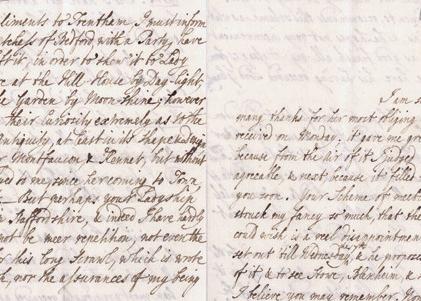
Find out more about life ‘below stairs’
We reveal the servants’ stories that have been uncovered through their diaries and letters.

Watch our Saxtead Green Post Mill video
See how the mill has been conserved and find out about the agricultural sites in our care.

Take our Women’s History Month quiz
Test your knowledge of important women in history with our tricky 20-question quiz.



Dennis McMillan asks…
Q How many people would it have taken to create Offa’s Dyke? Was it effective as a means of keeping the Welsh out of England?
Jeremy Ashbee replies…
A According to the archaeologist David H Hill, writing in The Antiquaries Journal, the dyke shows different construction in different sections, indicating that it was built by teams of men acting without knowledge of what others were doing. Estimating the numbers of men can only be speculative but, based on documentary evidence from around the time, Hill estimates that it would have been possible for 98 miles of the dyke to be worked on at a time. As for the purpose of the ditch, we can’t eliminate a genuinely military purpose – Offa did fight against the Welsh and actually died in battle, in 796. But we have to doubt that he was worried about a massive invasion, and more likely he was aiming to overawe the Welsh with a massive communal undertaking. As Hill commented, ‘We are looking at a mature, planned response rather than a panic measure.’
SEND US A QUESTION

Dawn Calvert asks…
Q I would like to visit Hadrian’s Wall for the first time this year but don’t know where to start. Where would you suggest?
Rachel Wilkinson replies…
A Personally, I would start at Birdoswald Roman Fort. It’s a great site for understanding Hadrian’s Wall and also has a café and museum. Birdoswald showcases the original turf wall along with the extensive remains of the Roman fort. Immediately east of Birdoswald is the longest continuous sweep of Hadrian’s Wall, punctuated by a number of milecastles and turrets. There are several different possible routes and I’d recommend using www.nationaltrail.co.uk/hadrians-wall-path to plan your walk and check terrain. Enjoy your trip!
Michael Varney asks…
Q Are there plans for collaborations with artists at any sites this year?
Dominique Bouchard replies…
A This year will have several new collaborations with artists, including Jacob Sam-La Rose our poet-in-residence, the Irelandbased sound art collective Softday, whose work Sounds of England will take place across 15 sites, and the National Youth Theatre, who we’re already working with on our national youth engagement programme Shout Out Loud. All of these arts programmes will include public performances and there will be other opportunities for members to get involved, either by participating in a poetry workshop, working with Softday to make recordings of the unique sounds and soundscapes at our sites, or by attending performances and installations.
For your chance to have your questions answered by one of our English Heritage experts, email us at membersmagazine@immediate.co.uk
Current catalogue price £45 each Special introductory price £35 each - a saving of £10 Even better - buy 2 for £60 and save £30 in total!
So pure Austrian cotton jersey with elegant collar and narrow placket, straight hem and side vents. Machine washable.
XS (30-32”) S (34-36”) M (38-40”) L (42-44”) XL (46-48”) £45 £35 each or buy 2 for £60 Postage & packing £5.50 FREE
UK 0333 043 9351 Overseas 00 44 16979 20637
(we are here 9am-6pm weekdays & 9am-5pm Saturday).
Order online www.countrycollection.co.uk or complete and return the Freepost coupon. O er ends 20th April 2020. Allow 7 days for delivery.
(current
in the ture make customers names available to selected trusted retailers, UK charities and organisations whose products we feel might be of interest to you. Should you prefer not to receive these postal mailings please tick this
From time to time, we’d like to send you our latest catalogue and special o ers by post. If you would prefer not to receive these, please tick this box








Developed from discussions with cultural heritage bodies, NGOs, military and police, this Master’s degree will provide you with real world skills that will enhance your employability.
Over the last decade, heritage crime has become an increasing issue across the world. Efforts from the international heritage community to tackle crime against cultural property have highlighted the increasing demand for highly qualified and skilled subject matter experts.
Subject to University approval, this course will be a highly hands on, forensic examination of the subject material.
Find out more E: cdsadmissionsoffice@cranfield.ac.uk T: +44 (0)1793 785220 www.cranfield.ac.uk/heritagecrime















Five of our unmissable Member-exclusive events over the months ahead
11 May
Tintagel Castle: Recreating the Historic Crossing Tintagel Castle, Cornwall
Join properties curator Win Scutt on a tour of Tintagel Castle and its new footbridge, which opened in August 2019. Experience the castle the way its medieval inhabitants once did – when Tintagel’s residents walked from one side of the site to the other using a narrow land bridge – and learn the secrets of one of Cornwall’s most impressive historic sites.
28 April
Reopening Saxtead Mill
Saxtead Green Post Mill, Suffolk
Join us at Saxtead Green Post Mill as it reopens after an extensive conservation project. One of many mills built in Suffolk from the late 13th century, the mill’s body revolves on its base, depending on the wind direction. Jonathan Sullivan, whose family have owned and cared for the mill for generations, tells the story of the mill’s conservation and history.
7 May
Helmsley Archaeological Store Tour – Wharram Percy
Helmsley Archaeology Store, North Yorkshire
Join Richard Mason, curator of collections and interiors, as we take a closer look at the vast collection from Wharram Percy – one of the largest and best preserved of Britain’s 3,000 or so known deserted medieval villages.


30 May
19 May
Kirby Hall, Northamptonshire
Join members of the Tudor and medieval costumed re-enactment band de Mowbray’s Musicke as they play their instruments – shawms, crumhorns and bagpipes – and describe their construction and use. You’ll also have the chance to join in with singing and dancing!
London’s Lost Rivers: The Hackney Brook Stoke Newington, London
This walk traces the route of the forgotten Hackney Brook, while telling how an idyllic village turned into an inner-city suburb, through multiple waves of immigration and gentrification, taking architecture as the points of reference. Expect tales of Stone Age hunters and a disrupted royal journey.
For more Members’ events, go to www.english-heritage.org.uk/members-events
Easter events
Events for everyone taking place over the Easter holidays

Easter Adventure Quest
Join the hunt for dragon eggs on a legendary quest this Easter holiday, and earn a reward courtesy of Hotel Chocolat. Bolsover Castle, Derbyshire, 4–19 April
Explore Photography at Stonehenge
Discover how people have captured their memories of Stonehenge. Stonehenge,Wiltshire, 4–19 April
Family Craft







For full listings of this season’s exclusive Members’ events, see your latest What’s On guide with this issue
Try out different arts and crafts while exploring the house. Kenwood, London, 5 April
Wallpaper Tours
Explore the amazing wallpaper rooms, which are rarely open to visitors. Wrest Park, Bedfordshire, 5 April
Falconry
Learn about the art of falconry and discover how birds of prey are trained. Richmond Castle, North Yorkshire, 10–13 April
www.english-heritage.org. uk/events










your
1 What is unusual about the blue plaque to the poet and dramatist Joanna Baillie?
2 Ada, Countess of Lovelace (1815–52, pictured below) has been called the world’s first what?

3 Margaret Brotherton, one of the richest women in England in the 1300s, lived in which castle after she was twice widowed?
4 Which mother and daughter share a blue plaque for their work as campaigners for women’s suffrage?
5 During the First World War, women came to Wrest Park in Bedfordshire (pictured below) to work as what?

6 Which influential woman was besieged at Dover Castle in 1265?
7 St Hild led one of the most important religious centres in the Anglo-Saxon world. What was it?
8 What was the name of the first woman to sit in parliament (pictured below)?
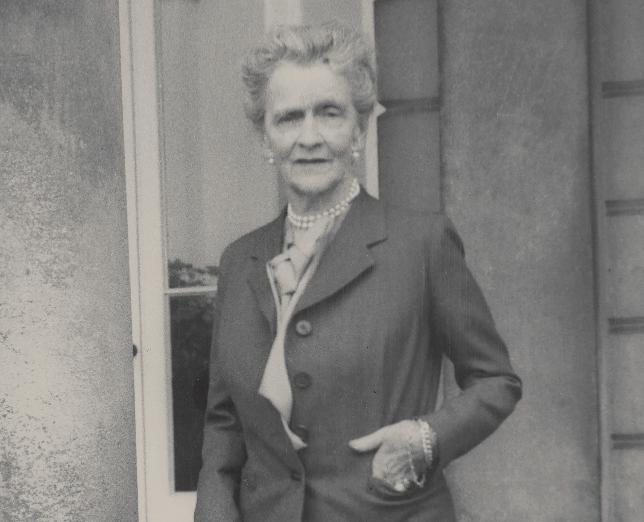
9 Eleanor Coade was a successful Georgian craftswoman who invented what?
10 Which property (pictured below) was built by Henrietta Howard?

11 Where did Amy Johnson start her journey when she flew from England to Australia in 1930?
12 Kitty Godfree held a world record for over 90 years in which sport?
13 Violette Szabo was the first British woman to be awarded what?
14 Who, in 1553, became England’s first official queen?
Logintothe Members’Areaat www.english-heritage. org.uk/members to checkyouranswers
15 Can you name any one of the five castles restored by Lady Anne Clifford?
16 Countess Isabella de Fortibus owned which island in the 13th century?
HolyIsland
IsleofWight
StMary’s
IsleofMan
17 For how many years did the reign of Queen Victoria (below) last?

18 Margery Kempe is arguably the author of the first what?
19 Which woman (below) was the first black broadcaster to be given her own series by the BBC?

20 Who inspired the 2015 film Queen of the Desert, starring Nicole Kidman?
Finchale Priory was founded in about 1196 on the site of the hermitage of St Godric, a former sailor who settled here after years of adventure
This year marks the 850th anniversary of the death of St Godric of Finchale. During his eventful 100-year life, he was a merchant, sailor, pilgrim, hermit, writer of religious verse and revered holy man. The son of Anglo-Saxons, Godric was born at Walpole, Norfolk in c.1070. At an early age he became a pedlar in Lincolnshire. His trade soon took him as far afield as Scotland and Flanders. He became a ship’s captain and part-owner of two vessels, making pilgrimages to Rome, Jerusalem and Santiago de Compostela. In the course of his seafaring, Godric also visited Farne Island off the coast of Lindisfarne where St Cuthbert (died 687) had sought seclusion. This inspired Godric to become a hermit.
He eventually settled, in around 1112, at Finchale, a remote site on the banks of the River Wear. Here he sought to atone for his past sins by living a life of almost unimaginable austerity. His diet initially consisted of roots and berries. Although he later cultivated barley and vegetables, he would only eat these when they were dry and mouldy. Labouring wearing a hair shirt and metal breastplate, he cleared forests to build himself a wooden oratory. Dedicated to the Virgin Mary, it had a barrel in its floor filled with freezing water in which Godric would immerse himself. He later built a stone chapel dedicated to St John the Baptist, whose life in the desert provided inspiration for medieval hermits.
Godric twice nearly lost his life, first to a flood and then to the hands of Scottish
‘Godric sought to atone for his past sins by living a life of austerity’

soldiers searching for treasure. Visitors with more peaceful intentions included two kings of Scotland and Aelred of Rievaulx. Credited with the ability to heal the sick and the power of prophecy, Godric also had the distinction of being the author of hymns in praise of the Virgin and St Nicholas, the patron saint of sailors.
Monks from Durham provided care for Godric in his old age. He died on 21 May 1170. His grave in the church of St John the Baptist at Finchale was the focus of
200 miracles and a priory was founded around it. In the late Middle Ages it was a holiday retreat for monks from Durham. Today, Finchale’s beautiful ruins are an enduring reminder of St Godric and his remarkable life.
FOLLOW IN HIS FOOTSTEPS
For more details and to plan a visit to Finchale Priory, go to www.englishheritage.org.uk/finchale-priory



Perhaps you’re not the only one wanting an easier way of getting around your home
Our stairlifts are perfect for regaining your independence, feeling confident on the stairs and also beating the rush for a bedtime story upstairs! Over the past 40 years we’ve helped more than 700,000 people around the world to enjoy the whole of their home again and we can help you too.
We have advisors nationwide, who can visit you at home to talk you through your options, show you how our stairlifts fit all kinds of stairs (and bears) and come in a wide choice of fabrics, colours and trims to suit your home. Installation usually takes just a few hours and
is stress free, and our engineers will leave your home as tidy as it was before.
Life at home is so much better when you can do the things you want to and simply keep on being you. Give us a call today. 150




TARGET MET

Lullingstone Roman Villa, Kent

£12,500 NEEDED

Hungerford Castle, Somerset

For more details and to donate, go to www.englishheritage.org.uk/ wallpaintings
£2,000 NEEDED

Chester Castle, Cheshire

£52,000 NEEDED
Longthorpe Tower, Cambridgeshire

TARGET MET


With your help we can stop these rare survivors disappearing forever
£2,000 NEEDED

Greyfriars’ Cloisters, Great Yarmouth

£17,000 NEEDED


£20,000 NEEDED

THANKS TO YOUR SUPPORT OUR FRAGILE WALL PAINTINGS ARE BEING SAVED, BUT THERE’S MORE TO DO…
Thank you to everyone who supported our appeal to protect and preserve our collection of precious wall paintings. With your help, we have now raised enough money to begin conservation work to save the irreplaceable paintings at Bolsover Castle, St Mary’s Church in Kempley and Lullingstone Roman Villa. However, there is still much to do and we urgently need your support to save the wall paintings at the Archer’s Pavilion at Wrest Park, Greyfriars’ Cloisters, Chester Castle, Farleigh Hungerford Castle and Cleeve Abbey, and to continue our work at Longthorpe Tower.

TARGET MET
St Mary’s Church, Kempley, Gloucestershire


Turn to page 34 to play your part in protecting irreplaceable wall paintings